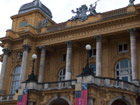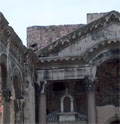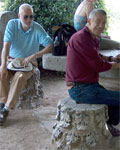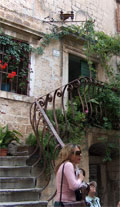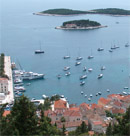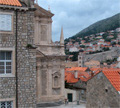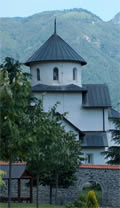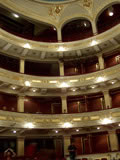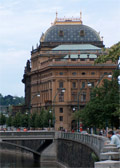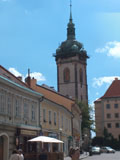 |
 |
 |
|
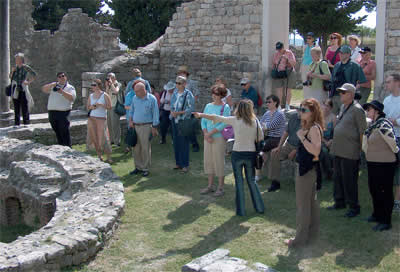 |
Members of USITT's 2007 Study Tour listen to information about Salona and document their visit. The tour visited many important sites before arriving in Prague for the opening of the 2007 Prague Quadrennial. To see a larger version of any image, click on the image. by Richard Durst
|
|
|
Study Tour Visits Balkans,
Prague Quadrennial In a substantial departure from previous Prague Quadrennial tours, the USITT delegation visited the Balkan countries of Croatia, Montenegro, and Serbia before the journey to the Czech Republic for the opening of the stunning 2007 exhibition. Based on advice from USITT friend and colleague Miodrag Tabacki from Belgrade, the tour began before the summer crowds headed for the Adriatic coastline and their vacations. The participants spent the first two weeks traveling together rather than starting with the more individualized exploration of PQ, as done in the past. Since none of this year's group had traveled to the Balkans, they enjoyed sharing the cities, islands, theatres, and museums as they learned about each other, building a closeness that carried through the entire tour. Zagreb At Mr. Tabacki's suggestion, the tour began in Zagreb, the Croatian capital, primarily because the state theatre Guidebooks and the Internet are not particularly kind to Zagreb, but the group found it a wonderfully clean and inviting city as tour members explored the museums and churches of the Upper and Lower Town. The Gothic style cathedral is remarkable and commands a prominent place above the newer city, although little remains from the original since it was all but destroyed by one of the region's devastating earthquakes. Split and environs The PQ's early June start date is partially due to the summer theatre festivals which occur all over Europe to allow designers to go to Prague before their seasons start. Unfortunately, it means Study Tours generally miss seeing theatre in any of the substantive venues. The Adriatic Coast is home to many wonderful street festivals in July and August and Split, a simply exquisite seaside resort city, was in the midst of its build cycle. Participants were able to tour the 1893 Croatian National Theatre, while they hauled a season's worth of props to storage. Much of the first day was spent in the The group detoured back through Sibenik just to see the barrel-vaulted Cathedral of Saint Jakov, another World Heritage Site, primarily because it was built without mortar of any kind. Hvar Because of necessary ferry connections, there were two consecutive early morning departures as participants visited the lovely island mecca of Hvar. This very small city is typical of Mediterranean seaports -- active harbor surrounded by islands, guarded by medieval fortresses, with steep streets and walkways. The group loved exploring the back alleys, with some of the most incredible bougainvillea. Originanally, the group planned to visit the oldest Baroque theatre in Croatia, but the city has decided to rebuild the theatre entirely, so the tour wasn't possible. The original theatre was on the second floor of the Arsenal, the most wonderful Renaissance building on the Dalmatian coast, but both the floor and roof were being replaced and the city wouldn't risk even a hard-hat tour. The cultural archivist showed a digital presentation of the history and plans of the theatre for about half the group, while the costume folks toured a lace museum with three of the nuns who operate it and make the wonderful lace they sell. Dubrovnik Dubrovnik is difficult to describe -- a walled city that rises out of the Adriatic with some of the most stunning views. Two-thirds of the buildings in the marvelous walled city were damaged in the war with Serbia in 1991-2, but it has been wonderfully restored with little evidence of damage except the new tiled roofs that dominate the Old Town. There were two relaxing days in the city at the beach and by the pool. In the heart of the Old Town, the group visited the City Theatre, which opened in its current configuration in 1662. The rear wall of the stage is the city wall of Dubrovnik! Participants headed into Montenegro, via Bosnia, plagued by rain for most of two days of visiting the historic towns of Kotor and Budva. Members enjoyed both walled cities, as they meandered through twisting streets and alleys. The skies cleared long enough for all to be amazed at the medieval fortress looming over Kotor.
Serbia On the trip into Serbia, in order to break up a long coach ride, the group spent parts of two days in Zlatibor, a winter ski resort (the surrounding countryside is reminiscent of the high plains in the western United States), where members rode a narrow-gauge railway to a mountain top, visited a film-set village built by Serbian filmmaker Emir Kusterica, and the ended the day in a reconstructed ethnographic village-museum that showed life as it would have been in earlier mountain settlements in Serbia. It was on to Belgrade by way of Topola, where the group visited another mausoleum decorated entirely with mosaics, then had a spectacular lunch in the "finest restaurant in all of Serbia," a hidden jewel in a tiny courtyard near this remote town. The next morning the group met Mr. Tabacki for a tour of the Participants visited the Atelje 212 theatre, a wonderful contemporary space, and the Yugoslav Drama Theatre, perhaps the finest theatre on the entire journey. Several of the group attended an evening performance courtesy of the theatre and raved about the spectacle. In the Study Tours over the years, groups have visited virtually every type of performance space from Greek and Roman amphitheatres to very contemporary spaces. On the way to the airport to leave for Prague, the group stopped at the Belgrade Arena, planned originally as an indoor sports arena but now being used primarily as a road-show house with 20,000 seats. The theatre consultants in the group were impressed by this Serbian-built facility, as members watched the setup of a British techno group and talked with the audio and light crew heads. Prague Finally, the ultimate goal -- the Prague Quadrennial, the world's largest exhibition of theatre design and architecture, with 60 countries exhibiting the finest examples of design for the theatre. The group arrived in the late afternoon the day before the PQ opening. After some of the group went on an The PQ can be daunting and many learned years ago to do the exhibits in small doses. A few of of the group joined tour coordinator, Martin Klimenta, for a Sunday morning exploration of New Town in Prague including the Peter and Paul cathedral and the surrounding fortress overlooking the Vlatva River. After several days of wandering the four exhibition spaces (the two national halls, the "schools" exhibit, and the central "performance" space), plus participating in workshops and meetings, the group went on a traditional excursion out of Prague, this time to Terezin. This Czech village became an internment camp for the Nazis during World War II, housing Jewish, political, and military prisoners. It was a somber reminder about inhumanity inflicted under the unforgivable guise of religious belief and ethnic superiority. It was a great group of travelers, including six students on USITT scholarships, two recent graduates, two young assistant professors, and some veterans. Once again, it was a pleasure to lead the tour and be a part of the adventures -- visiting theatres, experiencing other cultures, even just being a tourist. Stay tuned for 2009 as the Study Group will explore either Italy or Egypt. |
||
